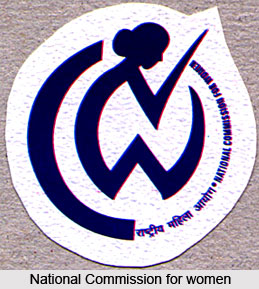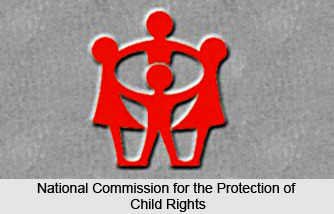 The Ministry of Women and Child Development has its origins in the Department of Women and Child Development which was set up in the year 1985 as a part of the Ministry of Human Resource Development. It was established with the intention of giving a much needed impetus to the holistic development of women and children. With effect from 30.01.2006, the Department has been upgraded to a Ministry.
The Ministry of Women and Child Development has its origins in the Department of Women and Child Development which was set up in the year 1985 as a part of the Ministry of Human Resource Development. It was established with the intention of giving a much needed impetus to the holistic development of women and children. With effect from 30.01.2006, the Department has been upgraded to a Ministry.
The broad objective of the Ministry is to have the holistic development of Women and Children. As a nodal Ministry for the advancement of women and children, the Ministry formulates plans, policies and programmes; enacts/ amends legislation, guides and coordinates the efforts of both governmental and non-governmental organisations working in the field of Women and Child Development. Besides, playing its nodal role, the Ministry implements certain innovative programmes for women and children. These programmes cover welfare and support services, training for employment and income generation, awareness generation and gender sensitization. These programmes play a supplementary and complementary role to the other general developmental programmes in the sectors of health, education, rural development etc. All these efforts are directed to ensure that women are empowered both economically and socially and thus become equal partners in national development along with men.
For the holistic development of the child, the Ministry has been implementing the world`s largest and most unique and outreach programme of Integrated Child Development Services (ICDS) providing a package of services comprising supplementary nutrition, immunization, health check up and referral services, pre-school non-formal education. Ministry is also implementing Swayamsidha which is an integrated scheme for empowerment of women. There is effective coordination and monitoring of various sectoral programmes. Most of the programmes of the Ministry are run through non-governmental organisations. Efforts are made to have more effective involvement of NGOs. The major policy initiatives undertaken by the Ministry in the recent past include universalisation of ICDS and Kishori Shakti Yojana, launching a nutrition programme for adolescent girls, establishment of the Commission for protection of Child Rights and enactment of Protection of Women from Domestic Violence Act.
The Ministry has 6 autonomous organisations- National Institute of Public Cooperation and Child Development (NIPCCD), National Commission for women (NCW), National Commission for Protection of Child Rights (NCPCR), Central Adoption Resource Agency (CARA), Central Social Welfare Board (CSWB) and Rashtriya Mahila Kosh (RMK) working under its aegis. NIPCCD and RMK are societies registered under the Societies Registration Act, 1860. CSWB is a charitable company registered under section 25 of the Indian Companies Act, 1956. These organisations are fully funded by the Government of India and they assist the Department in its functions including implementation of some programmes/schemes. The National Commission for Women was constituted as a national apex statutory body in 1992 for protecting and safeguarding the rights of women. The National Commission for Protection of Child Rights which is a national level apex statutory body constituted in the March 2007 for protecting and safeguarding the rights of children.
 Functions of Ministry of Women and Child Development
Functions of Ministry of Women and Child Development
The broad areas of responsibility of the Ministry of Women and Child Development include welfare of the family, women and Child Welfare and Coordination of activities of other Ministries and Organisation in connection with this subject, References from the United Nations Organizations relating to traffic in Women and Children, Care of pre-school children including pre-primary education, National Nutrition Policy, national Plan of Action for Nutrition and National Nutrition Mission, Charitable and religious endowments pertaining to subjects allocated to this Department, Promotion and development of voluntary effort on the subjects allocated to this Department. The Ministry also sees to the implementation of the Immoral Traffic in Women and Girl Act. 1956 (as amended upto 1986); The Indecent Representation of Women (Prevention) Act, 1986 (60 of 1986); The Dowry Prohibition Act 1961 (28 of 1961); The Commission of Sati (Prevention) Act, 1987 (3 of 1988), excluding the administration of criminal justice in regard to offences under these Acts; Implementation of the Infant Milk Substitutes, Feeding Bottles and Infant Food (Regulation of Production, Supply and Distribution) Act, 1992 (41 of 1992); Coordination of activities of Cooperative for Assistance and Relief Everywhere (CARE); The Child Marriage - Restraint Act, 1929 (19 of 1929).
The Children Act, 1960 (60 of 1960); Planning, Research, Evaluation, Monitoring, Project Formulations, Statistics and Training relating to the welfare and development of women and children, including development of gender sensitive data base. It co-ordinates the activities of the United Nations Children`s Fund (UNICEF); Central Social Welfare Board (CSWB); National Institute of Public Cooperation and Child Development (NIPCCD); Food and Nutrition Board; National Commission for Women; Rashtriya Mahila Kosh (RMK); The Juvenile Justice (Care and Protection of Children) Act, 2000 (56 of 2000).




















